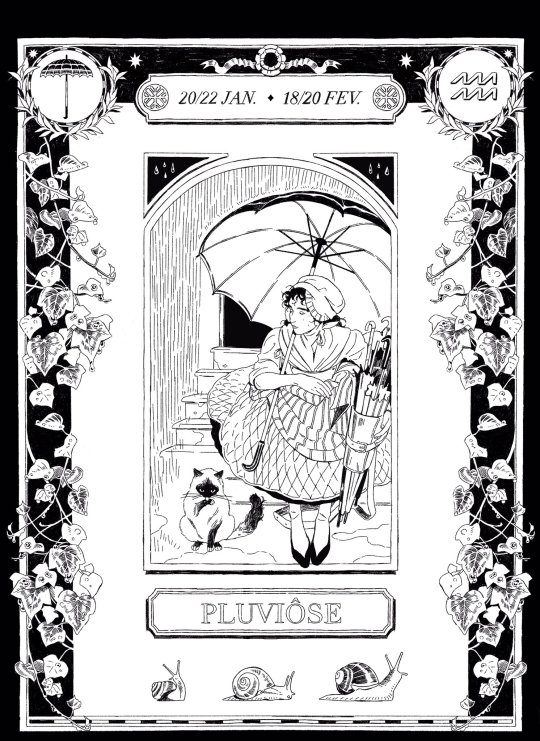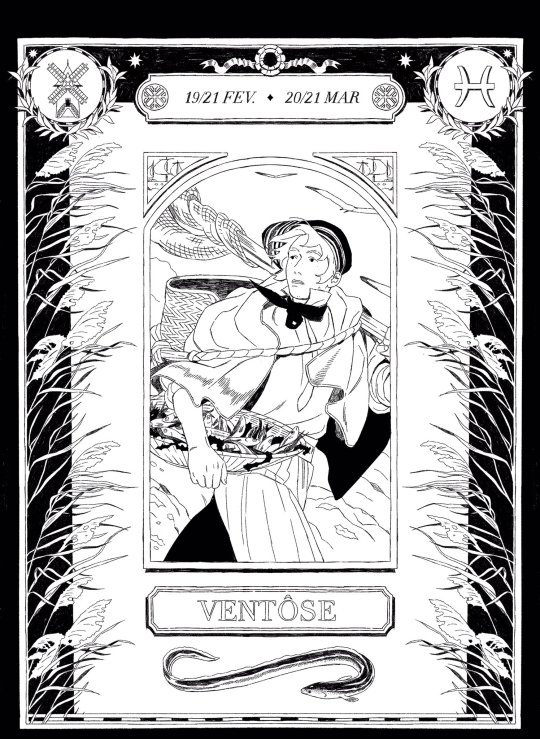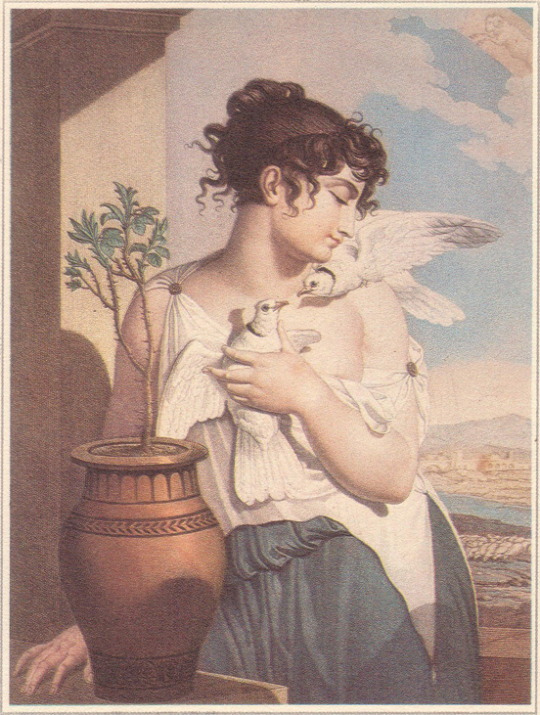#french calendar
Text
Duodi 22 Ventôse an CCXXXII
(lundi 11 mars 2024 / Monday March 11th, 2024)


Pendant la Révolution française, l'objectif était de créer une nouvelle société basée sur les idéaux de liberté, d'égalité et de fraternité. Le calendrier républicain était une manifestation de cette volonté de rupture avec l'ancien régime. Chaque jour de ce calendrier était dédié à une plante, un animal ou un outil, symbolisant ainsi les valeurs républicaines et l'importance de la nature dans la vie quotidienne.
Le mois de Ventôse dans le calendrier républicain français, correspondant généralement à la période entre le 20 février et le 20 mars, symbolisait le début de la transition vers le printemps. Associé au vent, ce mois était marqué par les premiers signes de renouveau et d'activités agricoles, préparant le terrain pour la saison à venir.
Le 22 Ventôse dans le calendrier républicain est appelé "journée du persil".
Cette journée était dédiée à la mise en avant du persil, une plante herbacée largement utilisée en cuisine pour sa saveur aromatique et ses propriétés médicinales. Pour comprendre l'importance de cette journée, il est nécessaire de connaître le contexte historique et culturel de l'époque.
Le persil, choisi pour être célébré le 22 Ventôse, était considéré comme une plante humble mais essentielle. Utilisé depuis l'Antiquité pour ses vertus médicinales et culinaires, le persil incarnait la simplicité et la vitalité. Sa présence dans de nombreux plats de la cuisine française en faisait un ingrédient familier pour le peuple.
La journée du persil était l'occasion de mettre en lumière l'importance des plantes aromatiques dans l'alimentation et la santé. Les républicains encourageaient la culture du persil dans les jardins potagers pour assurer une alimentation saine et diversifiée pour tous.
La journée du persil nous rappelle l'importance de valoriser les ressources naturelles et de promouvoir une alimentation équilibrée. Elle nous invite également à nous souvenir des idéaux de la Révolution française et de l'aspiration à une société plus juste et solidaire.
***
During the French Revolution, the objective was to create a new society based on the ideals of liberty, equality, and fraternity. The Republican calendar was a manifestation of this desire to break away from the old regime. Each day of this calendar was dedicated to a plant, an animal, or a tool, symbolizing republican values and the importance of nature in daily life.
The month of Ventôse in the French Republican calendar, generally corresponding to the period between February 20th and March 20th, symbolized the beginning of the transition to spring. Associated with the wind, this month was marked by the first signs of renewal and agricultural activities, preparing the ground for the upcoming season.
In the Republican calendar, the 22nd day of Ventôse is called "day of parsley".
This day was dedicated to highlighting parsley, an herb widely used in cooking for its aromatic flavor and medicinal properties. To understand the importance of this day, it is necessary to know the historical and cultural context of the time.
Parsley, chosen to be celebrated on the 22nd day of Ventôse, was considered a humble yet essential plant. Used since antiquity for its medicinal and culinary virtues, parsley embodied simplicity and vitality. Its presence in many French dishes made it a familiar ingredient for the people.
The parsley day was an opportunity to highlight the importance of aromatic plants in food and health. Republicans encouraged the cultivation of parsley in kitchen gardens to ensure healthy and diverse nutrition for all.
The parsley day reminds us of the importance of valuing natural resources and promoting a balanced diet. It also invites us to remember the ideals of the French Revolution and the aspiration for a fairer and more fraternal society.
#calendrier#calendrier républicain#calendrier républicain français#calendrier révolutionnaire#calendrier révolutionnaire français#france#français#révolution#ventôse#plante#french calendar#french#french revolution#french republic
14 notes
·
View notes
Text



The months of winter of the Republican calendar : Nivôse (the month of Snows), Pluviôse (the month of Rains) and Ventôse (the month of Winds) !
3K notes
·
View notes
Text

strong sad canonically listens to they might be giants and its fucking awesome
#phew! finished day 11! and it’s only (checks calendar) erm. uh oh#strong sad would totally be into crochet and he’d pronounce it with the worst most exaggerated french accent possible#homestar runner#strong sad#tmbg#my art :3#inktowbew
274 notes
·
View notes
Text
Forget astrology — which plant, animal or gardening tool is assigned to the day on which you were born?
#frev#french revolution#frev community#frev shitposting#history#history memes#18th century#1700s#French revolutionary calendar#astrology
97 notes
·
View notes
Text

She is a bit shy in door 8 today, but a very pretty French girl - L'Hermione

Départ de La frégate Hermione Lafayette du port de Brest, Fort du Dellec, 2019
More about her here:
Hermione is the name of the French frigate with which the Marquis de La Fayette returned to Boston in 1780 to support the American colonists in their fight for independence. The ship was completed in 1779 in the naval arsenal of Rochefort in a construction period of just eleven months, based on plans by Henri Chevillard and identical in construction to three other ships (la Courageuse, la Concorde, la Fée). These new light frigates were characterised by their manoeuvrability and speed. The Hermione was equipped with 26 cannons that could fire projectiles weighing 12 French pounds "poid de marc" (489.5 g). This is where the name "twelve-gun frigate" comes from. She also carried six or eight six-pounder guns. The empty weight was 1166 tonnes, the hull length 44.2 m, the overall length 65 m, the width 11.55 m and the depth 5.78 m. A sail area of more than 1500 m² was spread over three masts.
She experienced several battles and when the First Coalition War broke out on 20 April 1792, the Hermione returned to active service under Captain Martin. From 7 May 1793, she escorted convoys between Bayonne and Brest. In September 1793, she was tasked with escorting a convoy between the Loire estuary and the streets of Brest. On 20 September 1793, she ran aground off Le Croisic. The Hermione had a serious leak in the hull and could not be refloated in the receding tide. The crew threw 12 cannons and anchors overboard to stabilise the ship. The rising sea lifted the Hermione for a while, but she was so damaged that she could no longer pump water and sank to the bottom, where her hull began to disintegrate. At 1000 hours the next morning, Martin evacuated his crew in several fishing boats that had come to the rescue, salvaging as much equipment as possible, and was the last to leave the frigate.
The court martial that followed the wreck found the frigate's pilot, Guillaume Guillemin du Conquet, responsible for the frigate's loss; its commander, Captain Martin, was honourably acquitted.
A replica of the frigate has been under construction in a dry dock at the former Rochefort naval arsenal since 1997. As the original construction plans had been burnt for safety reasons, new plans had to be drawn up. The plans of a sister ship from the British Naval Museum, the Concorde, served as a model. The reconstruction of the Hermione was financed in part by the proceeds from the survey, grants from the French government and the EU as well as donations.
After its completion, the Hermione was launched in 2014. She left her building dock in early September 2014 for initial sea trials off the French Atlantic coast and sailed to North America in 2015, where she stayed for four months before sailing back. From 2 February 2018, the Hermione undertook a second major sea voyage from Rochefort to the Mediterranean via Tangier, Sète, Marseille and Toulon.
182 notes
·
View notes
Text
i still can't really have a conversation in french but i can read the french dictionary and i can translate 18th-century treatises on mollusks from french. that should count for something.
#-me to me after totally wiping out in conversation class#whatever!! i'm in conversation class to get better at conversation not because i'm already good at it!#<-repeating this to myself ten times a day#some of my classmates however. now those SOBs can converse. can they ever. you wouldn't believe#the conversations these assholes are having in front of me and trying to engage me in#such as 'where do you live?' and 'what do you do for exercise?'#and then i'm also supposed to think of questions to ask them. unfortunately when this happens i can't think of a single question#that has ever been posed in the history of human interaction#'do you like...uhhh...[sweating and eyes darting around] calendars?'#except i forget the word for calendar and say a made-up word#(this exact scenario has not occurred but in the broad strokes it is accurate and in the particulars it is only a matter of time)#every time someone asks me a question i want to say 'thanks for your question! you can expect a response in 2-3 business days.'#for some reason this is frowned upon however.#french
66 notes
·
View notes
Text

This is such a pretty picture of Napoleon, c. 1796
Portrait of General Bonaparte, 1796, by Louis Lafitte (Fondation Napoléon)
#love him 🥰#the artist was born the year after napoleon#he’s also the same artist who made the illustrations for the republican calendar#Louis Lafitte#Lafitte#Napoleon#napoleon bonaparte#portrait#napoleonic era#napoleonic#first french empire#french empire#france#history#art#drawing#french revolution#frev#1700s#18th century
124 notes
·
View notes
Text
December 25th is Nivôse 5 Dog Day on the French Republican Calendar and I think that is important to mention.

#french revolutionary calendar#french republican calendar#Cat Day is in January#frev#french revolution#maximilien robespierre#any errors on Brount is because google gave me conflicting ideas
401 notes
·
View notes
Text
Revolutionaries' Birthdays on the Republican Rural Calendar
Note: The Revolutionary Rural Calendar was designed in 1793 by Fabre d'Eglantine to replace the Catholic Saints calendar, and ultimately help secularize France. This just includes some of the most prominent revolutionaries' birthdays in the rural calendar format :) I think all the symbols are fascinating. My birthday symbol is a grape on the calendar!
Maximilien Robespierre:
6 May = 17 Floréal = Pimprenelle (Salad burnet)

Louis-Antoine de Saint-Just:
25 August = 8 Fructidor = Apocyn (Apocynum)

Jean-Paul Marat:
May 24 = 5 Prairial = Canard (Duck)

Camille Desmoulins:
2 March = 12 Ventôse = Orme (Elm)

Georges Danton:
26 October = 5 Brumaire = Oie (Goose)

#french revolution#french rev#frev#history#jean paul marat#marat#resources#saint just#camille desmoulins#maximilen robespierre#robespierre#danton#revolutionary calendar
114 notes
·
View notes
Text
Primidi 1er Germinal an CCXXXII
(Mercredi 20 mars 2024 / Wenesday, March 20th 2024)
🇨🇵 Texte en français et en anglais / Text in French and English 🇬🇧/🇺🇲


Le calendrier républicain, adopté pendant la Révolution française, était une tentative de rompre avec le passé monarchique et catholique en instaurant un système de mesure du temps basé sur les valeurs républicaines et agricoles. Chaque jour du calendrier républicain était dédié à une plante, un animal, un outil ou un événement symbolique, reflétant ainsi les idéaux de la Révolution.
Le mois de Germinal dans le calendrier républicain français représente le renouveau et la vitalité de la nature au printemps. Du 20 mars au 19 avril, Germinal est le mois où la terre se réveille de son sommeil hivernal, où les bourgeons éclosent et où les premières fleurs colorent les paysages. Il incarne le début de la saison des semailles et le travail de la terre, symbolisant ainsi l'espoir et la promesse d'une nouvelle récolte. Germinal rappelle également les idéaux républicains de liberté, d'égalité et de fraternité, en invitant chacun à contribuer à l'essor de la société et à cultiver un avenir meilleur.
Le 1er Germinal dans le calendrier républicain français, synonyme de printemps, est une journée dédiée à célébrer la beauté et la fraîcheur des primevères, ces magnifiques fleurs colorées qui annoncent l'arrivée des beaux jours.
Cette journée est l'occasion parfaite pour prendre conscience de la renaissance de la nature après les rigueurs de l'hiver. Les primevères, avec leurs pétales délicats et leurs couleurs vives, symbolisent cette période de renouveau et d'espoir.
À l'époque du calendrier républicain français, la journée du 1er Germinal, synonyme de printemps, était célébrée avec enthousiasme. Les citoyens se réunissaient dans les jardins publics et les parcs pour admirer les primevères en fleurs. Certains organisaient des expositions florales où les primevères étaient mises en valeur dans des arrangements artistiques.
En plus de leur beauté esthétique, les primevères ont également une importance écologique en tant que premières fleurs à fleurir au printemps, fournissant ainsi une source de nourriture essentielle pour les insectes pollinisateurs tels que les abeilles et les papillons.
En résumé, la journée du 1er Germinal est l'occasion idéale pour célébrer la beauté et la vitalité des primevères, tout en se reconnectant avec la nature et en appréciant les merveilles du printemps.
***
The Republican calendar, adopted during the French Revolution, was an attempt to break with the monarchical and Catholic past by establishing a system of time measurement based on republican and agricultural values. Each day of the Republican calendar was dedicated to a plant, an animal, a tool, or a symbolic event, thus reflecting the ideals of the Revolution.
The month of Germinal in the French Republican calendar represents the renewal and vitality of nature in spring. From March 20 to April 19, Germinal is the month when the earth awakens from its winter slumber, when buds open, and when the first flowers color the landscapes. It embodies the beginning of the sowing season and the work of the land, symbolizing hope and the promise of a new harvest. Germinal also recalls the republican ideals of liberty, equality, and fraternity, inviting everyone to contribute to the development of society and to cultivate a better future.
The 1st Germinal in the French Republican calendar, synonymous with spring, is a day dedicated to celebrating the beauty and freshness of primroses, these magnificent colorful flowers that herald the arrival of sunny days.
This day is the perfect opportunity to become aware of the rebirth of nature after the rigors of winter. Primroses, with their delicate petals and vibrant colors, symbolize this period of renewal and hope.
At the time of the French Republican calendar, the 1st Germinal, synonymous with spring, was celebrated with enthusiasm. Citizens gathered in public gardens and parks to admire the blooming primroses. Some organized floral exhibitions where primroses were showcased in artistic arrangements.
In addition to their aesthetic beauty, primroses also have ecological importance as the first flowers to bloom in spring, providing an essential food source for pollinating insects such as bees and butterflies.
In summary, the 1st Germinal is the ideal opportunity to celebrate the beauty and vitality of primroses, while reconnecting with nature and appreciating the wonders of spring.
#calendrier#calendrier républicain#calendrier républicain français#calendrier révolutionnaire#calendrier révolutionnaire français#france#français#révolution#plante#Germinal#nature#primeveres#révolution française#french#french republic#french revolution#french calendar#primrose#fleurs
16 notes
·
View notes
Text

a partridge in a pear tree
well, more or less
#silm#silmarillion#advent calendar#12 days of christmas#<- does valinor have a christmas adjacent holiday (like hobbits and their 'christmas trees'?#oh well it can be the 12 days of first-winter-at-cuivienen or something#not pictured:#earendil: how is that tree fruiting it is literally december#(answer: elwing is using her Weird Maia-ness to make it obvious that that is a pear tree)#holiday#i wonder how long ill be able to sustain this#i have an idea for the last one#and a few in between#and day 5 and 10 are pretty obvious#but what do i about french hens when there is no france.#oh well thats a problem for later
46 notes
·
View notes
Note
As a history professor, what stance do you take in the classroom on the B.C. / B.C.E. and A.D. / C.E. issue?
BCE and CE is creating a solution to a problem that does not exist, though for consistency we might also rename the days of the week and the names of the months to remove their offensive references to religion
636 notes
·
View notes
Text


Although, I talk a lot here about the traditions of my paternal Czech ancestors, this year I’ve been feeling a pull towards my maternal Québécois ancestors.
On February 2, French Canadian Roman Catholics celebrate the Fête de la Chandeleur (Candlemas), honoring the day in the church calendar when Mary took the baby Jesus to the temple, by eating crêpes (thin pancakes). A traditional French Canadian proverb says "Manger des crêpes à la chandeleur apporte un an de bonheur" (Eating crêpes on Candlemas brings a year of happiness).
Eating crêpes on February 2nd also has its origins in pagan festivals. At the time, Candlemas referred to the fertility of the earth. The peasants had thus made it a habit to cook pancakes with excess flour from last year. With their round shape and golden color, pancakes symbolized the light, sun, and therefore the return of sunny days. Superstitious, they even imagined a game to bring prosperity: to blow the first pancake with the right hand with a gold coin in the left hand.
Although often overshadowed by Groundhog Day in the media, Candlemas is still celebrated in regions with strong French traditions, such as Quebec, Acadia, Louisiana, the Mississippi Valley and Maine.
Some of my Duame ancestors:


And the Marlows (Marleaus):


The Thibodeaus:

Marriage of my Grandpa Elwin Marlow (Marleau) and Grandma Lorraine Thibodeau Marlow (Marleau):



18 notes
·
View notes
Text
It's always the Law of 22 Prairial this, the Coup of 18 Brumaire that... what about the Birthday of 21 Nivôse an XII (Paul Gavarni)??????
11 notes
·
View notes
Text

National Fry Day! - 7/13 | Bruschetta Fries
121 notes
·
View notes
Text

Floréal
Third in my series inspired by the months of the French Republican Calendar. Floréal is the second spring month, running from about the 20th of April to 19th of May. Since Floréal is named for the flowers of springtime, I went into this thinking I would recreate one of the glorious red poppy fields I saw in France as a teenager. But that was high summer. So I created picture that is truer to the springtime based on flowers one finds in the Loire Valley, namely bluebells blooming en masse before the oaks leafs out. The artistic style that inspired me was Raphael Kirchner's work for Puck Magazine--namely "Spring," from 1916.
#floreal#french revolution#French Republican Calendar#french revolutionary calendar#spring#bluebells#art nouveau#France
7 notes
·
View notes